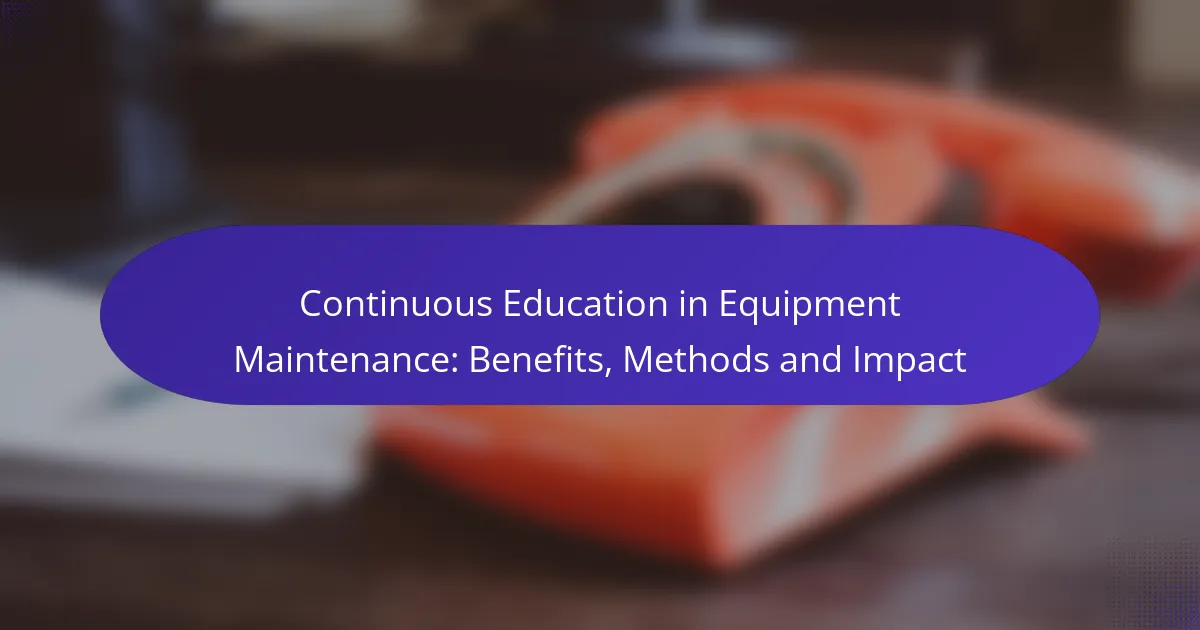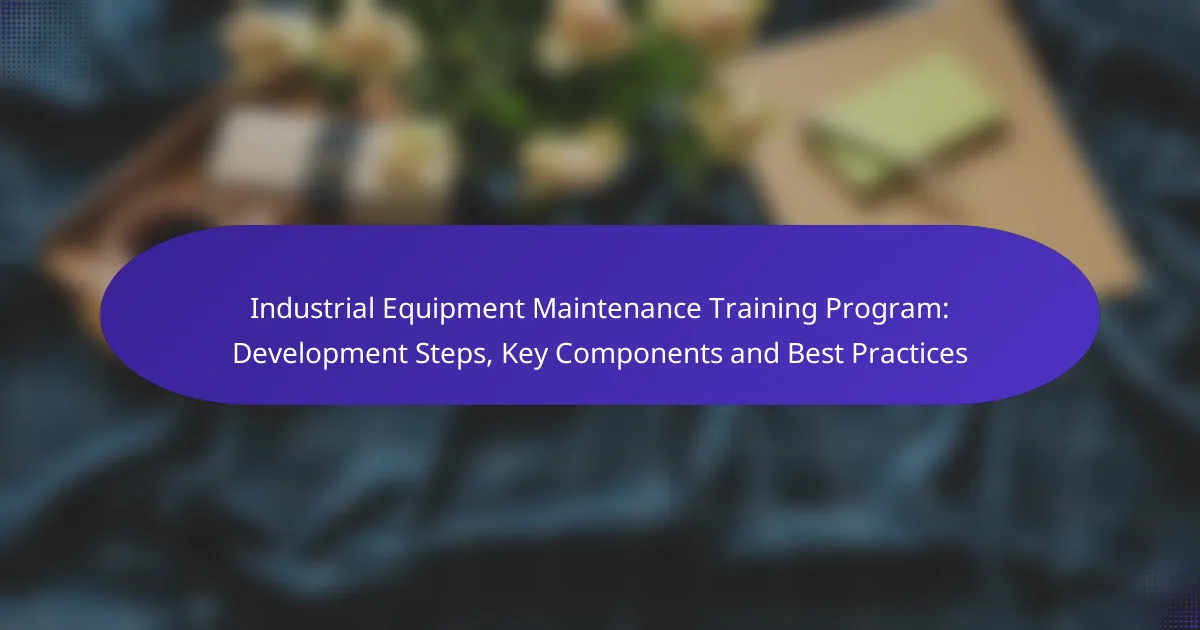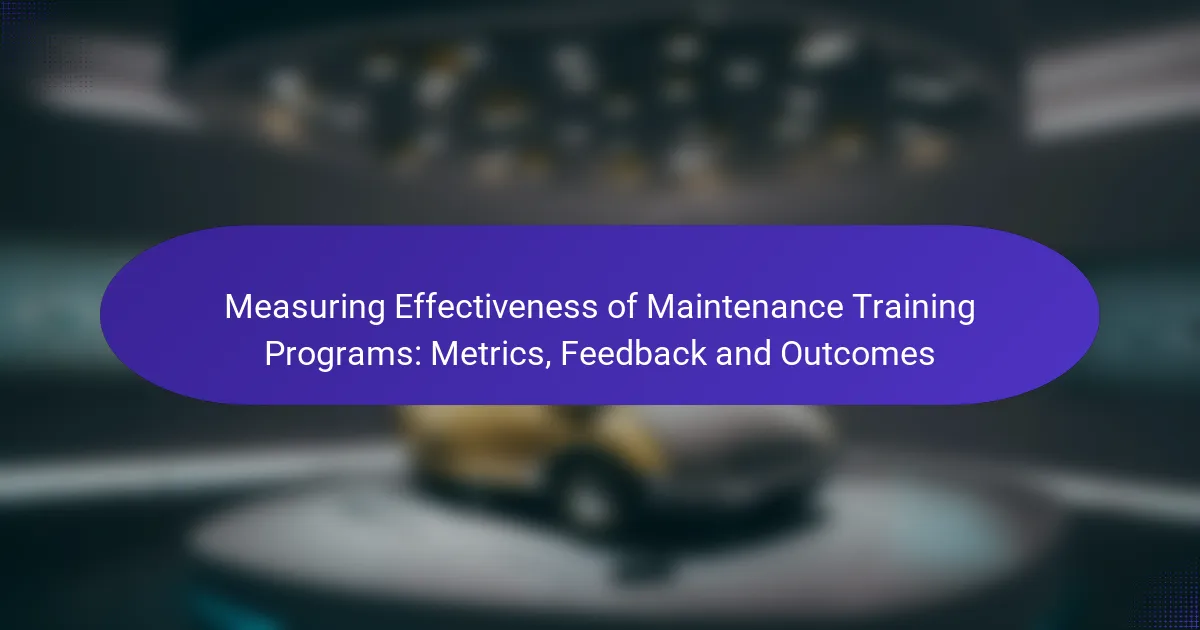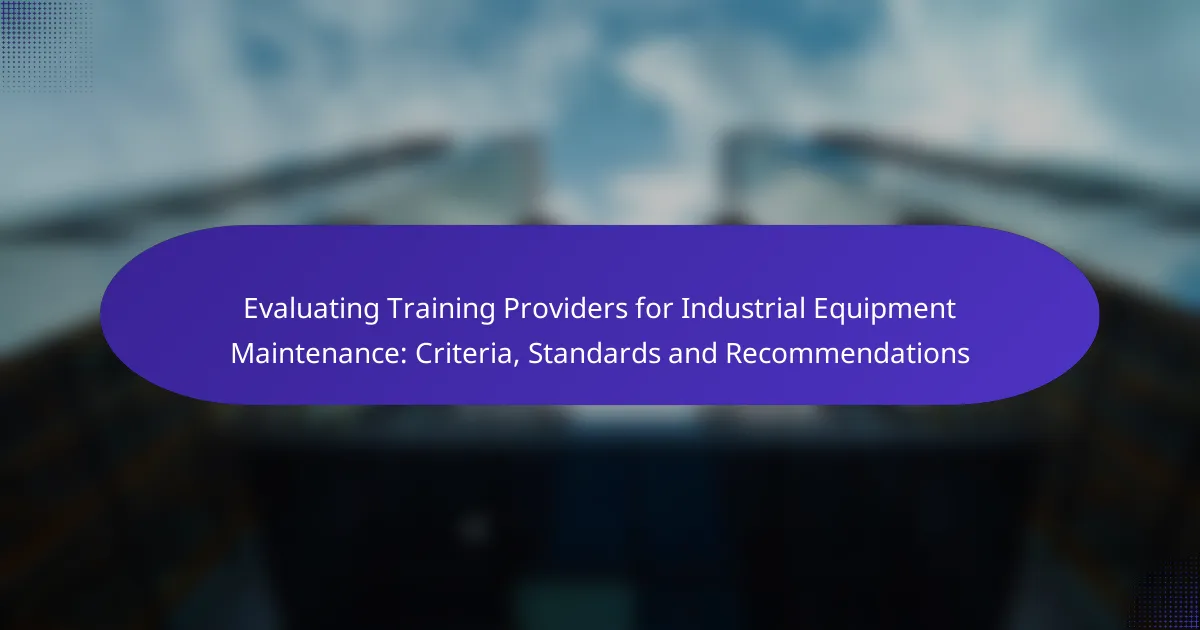Continuous education in equipment maintenance is essential for enhancing operational efficiency and workforce competency. By regularly updating skills and knowledge, organizations can better prepare their maintenance teams to tackle modern equipment challenges effectively. Various methods, such as on-the-job training and online courses, provide tailored learning opportunities that lead to improved maintenance outcomes and increased equipment reliability.
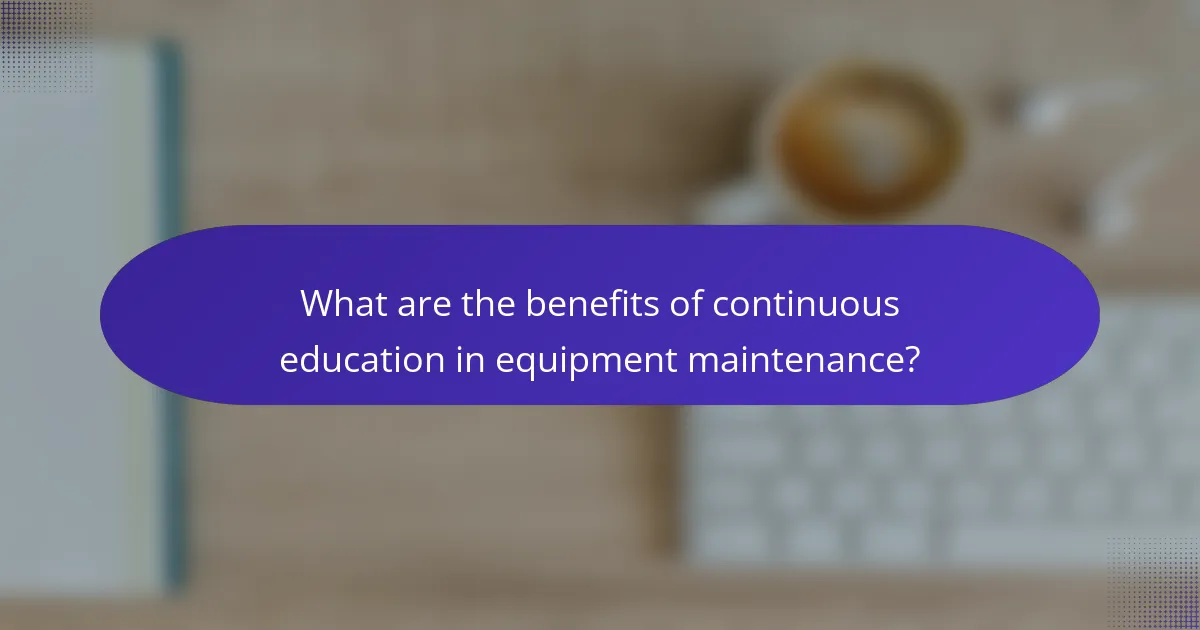
What are the benefits of continuous education in equipment maintenance?
Continuous education in equipment maintenance offers numerous advantages, including enhanced operational efficiency and improved workforce competency. By regularly updating skills and knowledge, organizations can ensure their maintenance teams are equipped to handle modern equipment challenges effectively.
Improved equipment reliability
Continuous education fosters a deeper understanding of equipment functionality and maintenance practices, leading to improved reliability. Technicians who are well-trained can identify potential issues before they escalate, ensuring that machinery operates smoothly and consistently.
For example, regular training on new technologies can help maintenance teams adapt quickly, reducing the likelihood of equipment failure due to outdated practices. This proactive approach enhances overall productivity and minimizes disruptions in operations.
Reduced downtime costs
Investing in continuous education can significantly lower downtime costs associated with equipment failure. When maintenance personnel are knowledgeable about the latest repair techniques and troubleshooting methods, they can resolve issues more quickly, minimizing the time equipment is out of service.
Organizations may find that well-trained staff can reduce downtime by 20-30%, translating to substantial savings in operational costs. This efficiency not only benefits the bottom line but also improves service delivery and customer satisfaction.
Enhanced employee skills
Ongoing training programs enhance the skill sets of maintenance employees, making them more versatile and effective in their roles. As they acquire new competencies, they become capable of handling a wider range of equipment and technologies.
Employers can encourage skill development through workshops, online courses, and certifications, ensuring that their teams remain competitive and knowledgeable about industry best practices. This investment in employee growth can lead to higher job satisfaction and retention rates.
Increased safety compliance
Continuous education plays a crucial role in maintaining safety compliance within equipment maintenance. Regular training ensures that employees are aware of the latest safety regulations and best practices, reducing the risk of accidents and injuries on the job.
By fostering a culture of safety through ongoing education, organizations can minimize liability and create a safer working environment. This commitment to safety not only protects employees but also enhances the company’s reputation and operational integrity.
Long-term cost savings
Continuous education in equipment maintenance leads to long-term cost savings by preventing costly repairs and extending the lifespan of machinery. Well-trained staff can implement effective maintenance strategies that reduce wear and tear on equipment.
Organizations can expect to see a return on investment through lower repair costs, reduced energy consumption, and extended equipment life. This proactive approach to maintenance can yield savings that accumulate over time, making it a financially sound strategy for businesses of all sizes.
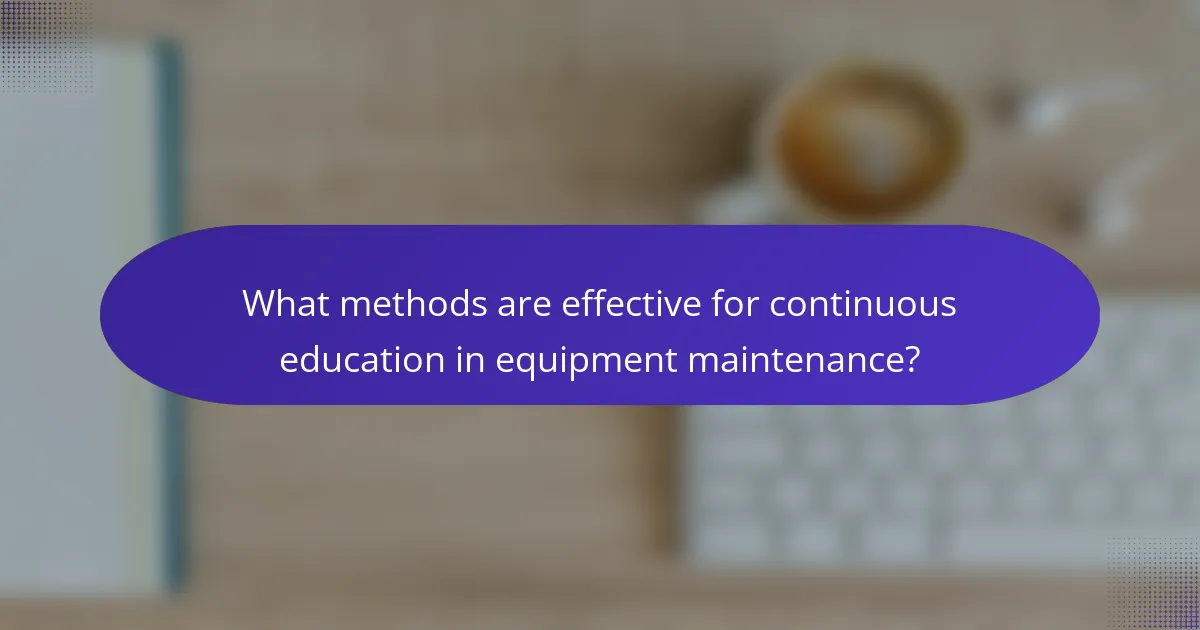
What methods are effective for continuous education in equipment maintenance?
Effective methods for continuous education in equipment maintenance include on-the-job training, online courses and webinars, workshops and seminars, and mentorship programs. Each method offers unique advantages and can be tailored to meet the specific needs of maintenance personnel.
On-the-job training
On-the-job training is a hands-on approach where employees learn maintenance tasks while working alongside experienced colleagues. This method allows for immediate application of skills and knowledge in real-world scenarios, enhancing retention and understanding.
To implement effective on-the-job training, ensure that trainers are well-versed in both the equipment and teaching techniques. Regular feedback and assessments can help identify areas for improvement and reinforce learning.
Online courses and webinars
Online courses and webinars provide flexible learning opportunities for maintenance staff, allowing them to study at their own pace. These resources often cover a wide range of topics, from basic maintenance principles to advanced troubleshooting techniques.
When selecting online courses, look for those that are accredited or recognized by industry standards. Incorporating interactive elements, such as quizzes or discussion forums, can enhance engagement and comprehension.
Workshops and seminars
Workshops and seminars offer concentrated learning experiences, often featuring expert speakers and hands-on activities. These events can be particularly beneficial for introducing new technologies or methods in equipment maintenance.
To maximize the impact of workshops, consider scheduling them regularly and ensuring they are relevant to current industry trends. Networking opportunities during these events can also foster collaboration and knowledge sharing among professionals.
Mentorship programs
Mentorship programs pair less experienced maintenance personnel with seasoned professionals, facilitating knowledge transfer and skill development. This personalized approach can significantly enhance the learning experience and build confidence in new technicians.
To establish a successful mentorship program, set clear goals and expectations for both mentors and mentees. Regular check-ins can help track progress and address any challenges that arise during the learning process.

How does continuous education impact maintenance outcomes?
Continuous education significantly enhances maintenance outcomes by equipping personnel with the latest skills and knowledge. This ongoing training leads to more effective maintenance practices, reducing downtime and improving equipment reliability.
Higher maintenance efficiency
Continuous education fosters higher maintenance efficiency by ensuring that technicians are up-to-date with the latest tools and techniques. This training allows them to perform tasks more quickly and accurately, which minimizes equipment downtime.
For example, a technician trained in the latest diagnostic software can identify issues in a fraction of the time compared to outdated methods. Organizations often see efficiency improvements of 20-30% after implementing continuous education programs.
Better problem-solving capabilities
With ongoing education, maintenance teams develop better problem-solving capabilities, enabling them to tackle complex issues more effectively. Training programs often include case studies and hands-on simulations that enhance critical thinking skills.
As a result, technicians can analyze problems more thoroughly and implement solutions that prevent future failures. This proactive approach can lead to a significant reduction in repeat issues, saving both time and resources.
Improved team collaboration
Continuous education promotes improved team collaboration by fostering a shared understanding of maintenance practices and goals. When all team members are trained similarly, communication becomes clearer, leading to more cohesive teamwork.
Regular training sessions can also serve as team-building exercises, helping to break down silos and encourage knowledge sharing. This collaborative environment can enhance overall productivity and morale within the maintenance team.

What are the prerequisites for implementing continuous education programs?
To successfully implement continuous education programs in equipment maintenance, organizations must evaluate their existing capabilities, identify specific training needs, and allocate an appropriate budget for training initiatives. These steps ensure that the programs are tailored to enhance skills effectively and efficiently.
Assessment of current skills
Assessing current skills involves evaluating the existing competencies of maintenance personnel. This can be achieved through performance reviews, skill assessments, or feedback from supervisors. Understanding the baseline skills helps in determining the gaps that need to be addressed through training.
Consider using a skills matrix to visualize the strengths and weaknesses of your team. This tool can highlight areas where further training is necessary, ensuring that the education programs are focused and relevant.
Identification of training needs
Identifying training needs requires a thorough analysis of both the current skill gaps and the future demands of equipment maintenance. Engage with employees to gather insights on areas where they feel additional training would be beneficial. This participatory approach can lead to more effective training programs.
Additionally, consider industry trends and technological advancements that may require new skills. For example, if your organization is adopting new maintenance technologies, training programs should be designed to cover these innovations.
Budget allocation for training
Budget allocation for training is crucial to ensure that continuous education programs are sustainable. Organizations should determine a realistic budget based on the number of employees to be trained, the type of training required, and the frequency of training sessions. A common practice is to allocate a percentage of the overall training budget specifically for equipment maintenance.
When planning the budget, consider both direct costs (such as training materials and instructor fees) and indirect costs (like employee time away from regular duties). It may be helpful to explore funding opportunities or grants that support workforce development in your industry.
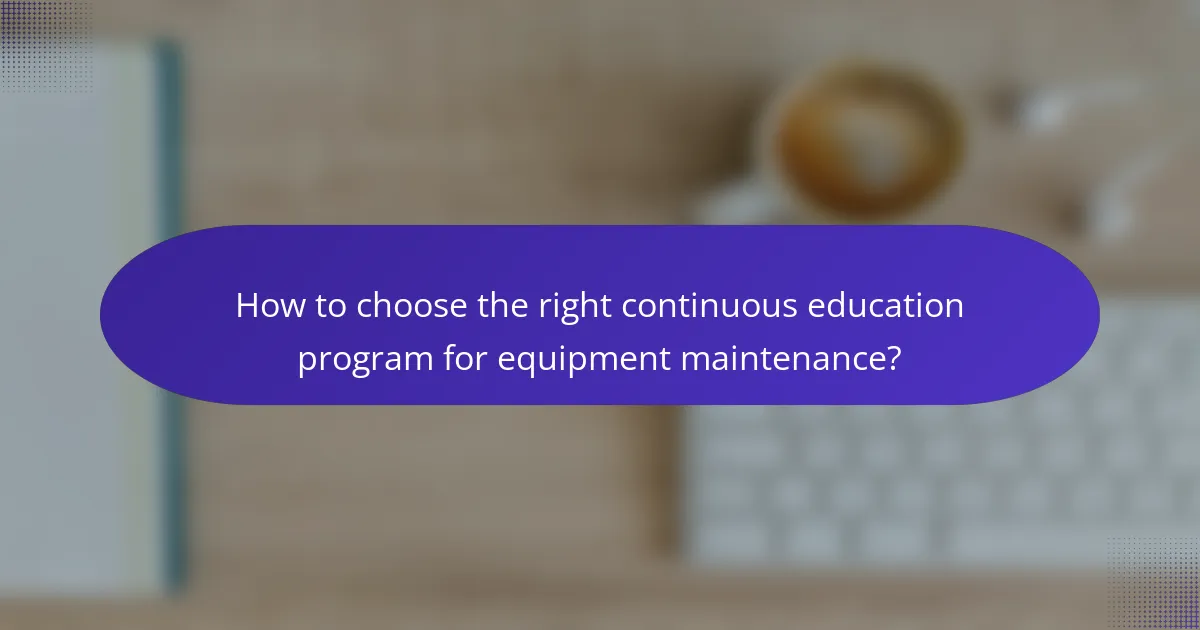
How to choose the right continuous education program for equipment maintenance?
Selecting the right continuous education program for equipment maintenance involves assessing your specific needs, the program’s relevance, and its delivery format. Consider factors such as the curriculum, instructor qualifications, and the flexibility of scheduling to ensure it aligns with your professional goals.
Identify your specific needs
Understanding your specific needs is crucial when choosing a continuous education program. Assess the types of equipment you work with and the skills you want to enhance. For instance, if you primarily maintain industrial machinery, look for programs that focus on mechanical systems and troubleshooting techniques.
Evaluate program content and delivery
Review the curriculum of each program to ensure it covers essential topics such as preventive maintenance, safety standards, and equipment diagnostics. Additionally, consider the delivery method—online courses offer flexibility, while in-person training may provide hands-on experience. A mix of both can be beneficial.
Check instructor qualifications
The qualifications of instructors can significantly impact the quality of education. Look for programs led by experienced professionals with practical knowledge in equipment maintenance. Instructors with industry certifications or teaching experience can provide valuable insights and real-world applications.
Consider accreditation and recognition
Accreditation can indicate the quality and credibility of a continuous education program. Programs recognized by industry bodies or educational institutions may carry more weight in your professional development. Verify if the program meets local regulations or standards relevant to your field.
Assess flexibility and accessibility
Flexibility is essential for busy professionals. Check if the program offers asynchronous learning options or weekend classes to accommodate your schedule. Accessibility is also important; ensure that the program is available in your region or online to avoid travel constraints.
Gather feedback and reviews
Before committing to a program, seek feedback from past participants. Reviews can provide insights into the effectiveness of the program and the satisfaction of former students. Look for testimonials that highlight the program’s strengths and any potential weaknesses.
